-

《念奴娇·赤壁怀古》说课稿(二) 2022-2023学年统编版高中语文必修上册
读,是学生接触作品最直接的方式。初读词作,让学生听示范读,并且在课本注解的提示下,解决词作的读音问题。再进一步了解词人情况、本词的创作背景以及怀古咏史诗词的基本情况。通过齐读的方式,亲身感受词作的音韵之美。读,是放飞想象的最好方式。再读词作,通过诵读上阙内容,想象上阙描绘了一幅什么样的情景?用了哪些富有表现力的词来极力描绘这些景象?呈现出何种意境?有何作用?并且利用智慧课堂进行填空和选择。读,是把握内容的最有用的方式。通过智慧课堂随机选择,引导学生分角色诵读下阙,分析三国时的周瑜与此时的词人苏轼的形象。在对比中,感受周瑜的情场、官场、战场,场场得意的情况,和苏轼的黄州、惠州、儋州,州州失意的人生境遇。理解周瑜之于苏轼而言,是某种程度上热切向往的和难以企及的梦。读,也是赏析体悟作品主要方式。学生再次齐读下阙,赏析词作最后两句“人生如梦,一尊还酹江月”表达了作者怎样的情感?来完成本篇内容的学习。
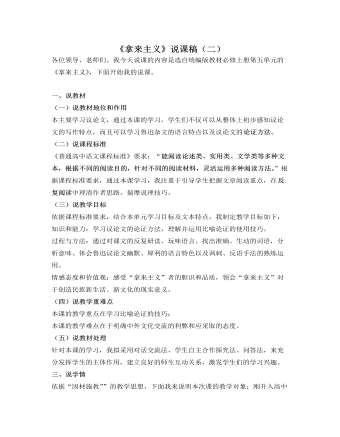
《拿来主义》说课稿(二) 2021-2022学年统编版高中语文必修上册
四、说教学过程(一)结合现实、自然导入随着我国开放的深入发展,国外的科学、文化、技术以及资产阶级的腐朽思想,生活作风等等也随之大量涌来,我们应采取怎样的态度和方法才是正确的呢?鲁迅先生在30年代就继承文化遗产问题曾写过一篇杂文,我们可以从中获得那些启示呢?(二)整体感知、疏瀹文意1.请同学介绍“我所知道的鲁迅”,教师补充写作背景。教师有针对性的进行预习检查,能促使学生养成课前预习的习惯。2.理清文章的思路,分析文章的整体结构教师范读课文,针对较难的字音进行正读。学生快速浏览课文,把握全文框架,小组讨论后分出层次。(让学生通过自主合作探究来概括文意可以让同学们参与到教学活动中,锻炼学生实际动手能力)

《荷塘月色》说课稿 (二)2021-2022学年统编版高中语文必修上册
本环节利用多媒体展示的教学手段,通过创设优美的情景来渲染气氛,引导学生接受美的熏陶,增强学生学习兴趣。教师先播放莲花的图片,让学生们谈谈自己联想到的诗词曲赋或文章,来激发学生的学习热情,随后教师总结,引出现代写荷花的名篇《荷塘月色》,从而导入新课。导语部分的设计既给了学生美感享受又自然的导入了新课。(二)初读文本,把握结构本环节主要采用了小组合作法让学生以小组合作的形式探索文章夜游顺序和情感变化这两条线索发展,教师适当的进行点拨,让学生通过探索文章线索完成对本课“圆形结构”把握。目的是发挥学生主导作用,自主学习、把握文章结构美。(三)选读文本,分析手法在本环节中主要运用讲授法和问答法。让学生反复诵读课文第4、5、6段,找出作者使用修辞手法修饰了的景物,随后师生问答作者运用了什么修辞手法来描写“荷塘”“月色”“荷花”“荷香”等景物的,又达到了什么样的效果呢?最后由教师来具体讲解本文中学生不熟悉的写作手法(如:通感)。
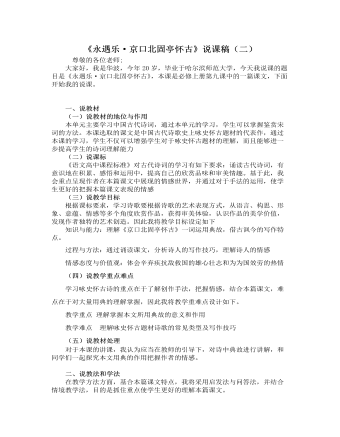
《永遇乐 · 京口北固亭怀古》说课稿(二) 2021-2022学年统编版高中语文必修上册
此环节运用的是合作探究法,采用小组讨论的形式开放回答即可。通过本课的学习,学生可以总结归纳出辛弃疾主张抗敌,收复失地的爱国热情对南宋政府苟且偏安的不满,吸取的历史教训,告诫当使用者不要草率用兵。对于决策者提出警告,抒发自己壮志难酬的感慨,教师总结归纳即可。本诗写出最大特点就是大量典故的运用。学生可以本诗对用点表达自己的看法,我将在在PPT展示诗歌用典的意义,意在帮助学生理解更好用典这种诗歌技巧。本篇是一首咏史怀古诗,本单元学习了两首同题材诗歌,有必要使学生掌握一类型的诗歌鉴赏方法。(五)比较阅读 品味历史这一环节PPT将展示上次课程学习的《念奴娇赤壁怀古》并从内容,形式等角度分析异同,采用提问的方法。此环节结束后简要归纳咏史怀古诗类型。目的是巩固加强对于咏史怀古题材诗歌理解,理解归纳咏史怀古诗题材类型。(六)布置作业 巩固感知鉴赏李白《越中览古》我将采用习题的形式,目的是使学生在实践中运用所学方法鉴赏咏史怀古诗。
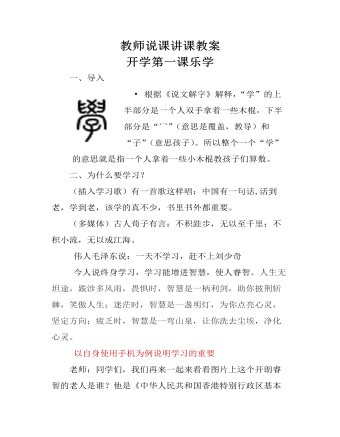
教师说课讲课教案开学第一课乐学
二、为什么要学习?(插入学习歌)有一首歌这样唱:中国有一句话,活到老,学到老,该学的真不少,书里书外都重要。(多媒体)古人荀子有言:不积跬步,无以至千里;不积小流,无以成江海。伟人毛泽东说:一天不学习,赶不上刘少奇今人说终身学习,学习能增进智慧,使人睿智。人生无坦途,跋涉多风雨,畏惧时,智慧是一柄利剑,助你披荆斩棘,笑傲人生;迷茫时,智慧是一盏明灯,为你点亮心灵,坚定方向;疲乏时,智慧是一弯山泉,让你洗去尘埃,净化心灵。
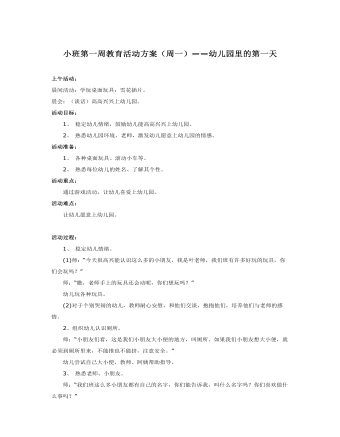
小班第一周教育活动方案课件教案
晨会:(谈话)高高兴兴上幼儿园。活动目标:1、稳定幼儿情绪,鼓励幼儿能高高兴兴上幼儿园。2、熟悉幼儿园环境、老师,激发幼儿愿意上幼儿园的情感。活动准备:1、各种桌面玩具、滚动小车等。2、熟悉每位幼儿的姓名、了解其个性。活动重点: 通过游戏活动,让幼儿喜爱上幼儿园。活动难点: 让幼儿愿意上幼儿园。
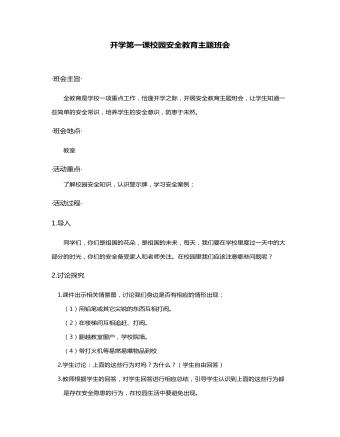
开学第一课安全教育主题班会教案
教师出示相关校园安全知识。(1)食品安全a. 不到没有卫生许可证的小摊贩处购买食品,选择新鲜和安全的食物;注意查看食品的保质期限、配方等安全信息。b. 养成良好的卫生习惯,饭前洗手。 c. 彻底洗净蔬果;不吃霉变的食物;不吃生食;尽量不吃剩菜剩饭。d. 保持健康的饮食习惯,不把饮料当水喝,不吃烧烤、油炸、烟熏及膨化食品,注意三餐定时定量。(2)人身安全 a.有序进出教室,上下楼梯靠右行,不拥挤或互相推搡。 b.在校园追跑打闹。不爬学校的围墙,门窗、围栏、树木、球架。 c.课外活动和体育锻炼,要按有关安全规则进行。在往返家校的路上,要注意交通安全,行路要严格遵守交通规则。 d.不得携带管制刀具,违禁物品进校园。(3)消防安全 a.不携带易燃、易爆、有毒物品等进入校园。 b.若插座、照明灯、电风扇等电器发生故障,不得私自动手排除,应报告教师或总务处,由学校电工进行故障排除。

《开学第一课-安全教育》主题班会教案
教学目标:1.充分认识安全工作的重要意义;2.在学习和生活中注意人生安全、饮食安全、交通安全等;3.进行预防灾害,预防突发事件的教育。教学过程:1.导入:列举出生活中的安全事例。2.安全工作的重要性a 公路上、公共场所的安全事故时有发生,是因为有的人安全意识不强。b 班级举例:学校发生的事故及后果。c 目前学校抓的几项工作。小学生应该注意安全的地方:1.学生讨论。2.集体归纳。(1)人身安全,在校园内或公路上不追逐打闹,不爬围墙,不爬树,不接近有电等危险地点,劳动时,注意安全,不与社会上不三不四的人交往,课外不玩火,不玩水。(2)交通安全,在公路上不追逐打闹,自觉遵守交通规则,交叉路口要注意行人车辆,通过公路要做到一停二看三通过。
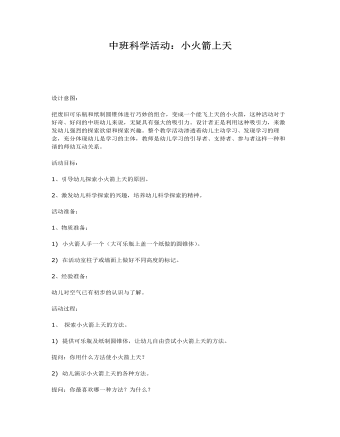
中班科学活动 《小火箭上天》课件教案
活动目标:1、引导幼儿探索小火箭上天的原因。2、激发幼儿科学探索的兴趣,培养幼儿科学探索的精神。活动准备:1、物质准备:1) 小火箭人手一个(大可乐瓶上盖一个纸做的圆锥体)。2) 在活动室柱子或墙面上做好不同高度的标记。
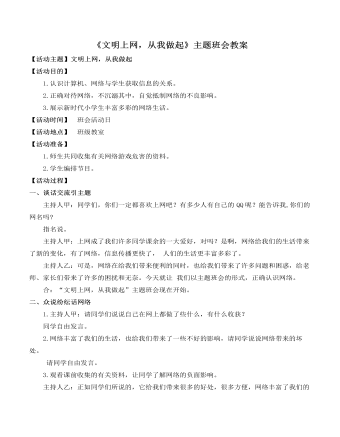
《文明上网,从我做起》主题班会教案
2009年9月,武汉一位母亲为了劝说长期沉迷于网吧的儿子,以跳江寻死相谏。马强原来在一所小学读书,学习成绩优秀,身体健康,爱打乒乓球。自从玩上电脑游戏后,马强无心学习,经常一连几天泡在网吧里。有一次马强连续几天玩电脑游戏,眼睛突然看不见了,医生说是“暴盲”。眼睛治好后,马强继续经常长时间泡在网吧,后来发展到没有钱玩电脑游戏就去偷盗,并参与团伙抢劫,直到最后被抓住。(2)主持人展示一组触目惊心的数据。甲:让我们再来看看这样一组数据。(课件出示)据最新统计,我国网民超过一亿,其中青少年网民占80%,青少年上网大多以玩游戏和聊天为主,网络成瘾、网络受骗、网络犯罪等问题日益突出。我国网络成瘾的青少年高达250万人,14岁到24岁是网瘾最高发的时期,占整个网瘾青少年的90%。因为上网,全国的青少年犯罪率以每年10%的速度增长。
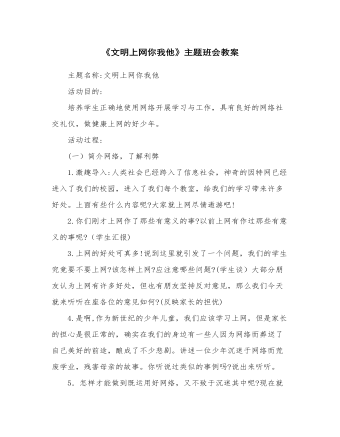
《文明上网你我他》主题班会教案
5.怎样才能做到既运用好网络,又不致于沉迷其中呢?现在就让我们一起去儿童健康上网中心看一看,一定会对你有所帮助的。(二)剖析自我,坦露心声导语:我们这里来了一位叫小明的朋友,他有烦恼向我们倾诉,你们听。1.课件中的小明诉说自己在上网时常遇到不适合我们看的内容,感到很烦恼,希望大家给他出出主意。(同学们各抒己见)2.你们在与网络相处的过程中一定也会遇到不少麻烦,能说给大家听听吗?3.看到同学们如此真诚,还有几位网迷也想同大家认识,他们正在会友室等着大家。注意:边听他们的介绍,边问问自己:我的上网情况和谁最相似?欢迎大家说真话。(点击课件进入会友室)有六位小网迷逐一介绍:
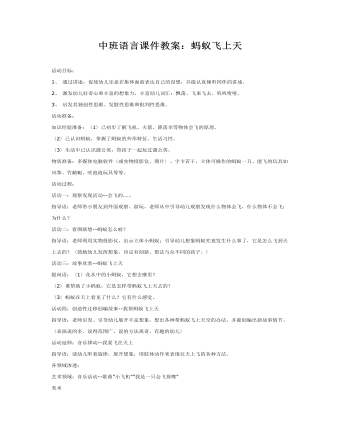
中班语言课件教案:蚂蚁飞上天
2、激发幼儿好奇心和丰富的想象力,丰富幼儿词汇:飘荡、飞来飞去、叽叽喳喳。3、启发其独创性思维、发散性思维和批判性思维。活动准备:知识经验准备:〈1〉已初步了解飞机、火箭、降落伞等物体会飞的原理。〈2〉已认识蚂蚁,掌握了蚂蚁的外形特征、生活习性。〈3〉生活中已认识蒲公英,带孩子一起玩过蒲公英。物质准备:多媒体电脑软件〈或实物投影仪、图片〉、字卡若干、立体可操作的蚂蚁一只、能飞的玩具如风筝、竹蜻蜓、吹泡泡玩具等等。活动过程:活动一:观察发现活动--会飞的……指导语:老师带小朋友到外面观察、游玩,老师从中引导幼儿观察发现什么物体会飞,什么物体不会飞;为什么?活动二:看图联想--蚂蚁怎么啦?指导语:老师利用实物投影仪,出示立体小蚂蚁;引导幼儿想象蚂蚁究竟发生什么事了,它是怎么飞到天上去的?〈鼓励幼儿发挥想象,肯定有创新、想法与众不同的孩子。〉

新人教版高中英语必修2Unit 1 Cultural Heritage-Discovering Useful Structure教案二
This theme of the part is “ Describe people or things in greater detail”. Students have learned the grammar(restrictive relative clauses) in Book 1, and further review and consolidate its structure “prep+relative pronouns(which/whom)” and the relative adverbs(when, where and why), besides students should understand its form, meaning and functions. In this section, students should be able to express the grammar correctly in daily communication and in the writing. 1. Review the basic usages of relative pronouns and adverbs of attributive clauses . 2. Learn to use some special cases about restrictive relative clauses.3. Learn to write sentences with restrictive relative clauses flexibly according to the context.1. Review the basic usages of relative pronouns and adverbs of attributive clauses .2. Learn to use some special cases about restrictive relative clauses.3. Learn tow rite sentences with restrictive relative clauses flexibly according to the context.Step 1. Observe the following sentences, and mark the relative pronouns and the adverbs. 1. After listening to the scientists who had studied the problems, and citizens who lived near the dam, the government turned to the United Nations for help.2. Temples and other cultural sites were taken down piece by piece, and then moved and put back together again in a place where they were safe from the water.Step 2 PracticePlease complete these sentences with relative pronouns and relative adverbs and answer the following questions.Questions: 1. What is the head noun ?2. What relative words should be used ?3. What elements do they act in these sentences ?

新人教版高中英语必修2Unit 2 Wildlife Protection-Reading for Writing教案二
This lesson aims at making a poster about protecting wildlife after reading some posters. During reading students are guided to understand the content and try to summarize the posters with one sentence. Then students are guided to try to make a poster about protecting wildlife.1. Read the two posters and try to understand the summary sentences.2. Look at the two posters and try to understand what emotions they express.3. Try to summarize the features of posters4. Try to make a poster about wildlife.1. Look at the two posters and try to understand what emotions they express.2. Try to summarize the features of posters3. Try to make a poster about wildlife.Step 1 Lead inLook at the the posters on the textbook and ask:Which emotions do the posters communicate ?Step 2 Read the poster and answer the questions.1. What do you think of the animals in the poster on the left ?I think it is frightening and ugly.2. Why do we should protect the ugly animals ?All species--the good, the bad, and the ugly-- should be treated equally.The world needs all kinds--without variety, our planet cannot survive.3. Why are billions of trees being cut down every year ?To make paper for humans.4. What result will be lead to after the trees are cut down ?A lost of animal homes are being destroyed./The habitat of wildlife is being destroyed.Step 3 Find the feature of posters1. What does each poster use to stir up emotions ?On the left, it makes us a little frightened and it looks a little ugly, but it can activate our curiosity--What is it? And What is wrong with it?On the right, it makes us feel a little sad and want to protect them.

新人教版高中英语必修2Unit 1 Cultural Heritage-Reading and Thinking教案二
1. This section focuses on "Understanding how a problem was solved”, which is aimed to guide students to analyze and discuss the challenges and problems faced by cultural heritage protection during the construction of Aswan Dam, as well as the solutions. On the basis of understanding, students should pay attention to the key role of international cooperation in solving problems, and attach importance to the balance and coordination between cultural heritage protection and social and economic development. Students are encouraged to face challenges actively, be good at cooperation, and make continuous efforts to find reasonable ways and means to solve problems.2. Enable students to understand the main information and text structure of the reading text;3. Motivate students to use the reading strategy "make a timeline" according to the appropriate text genre;4. Enable students to understand how a problem was solved;5. Enable students to understand the value of protecting cultural heritage by teamwork and global community;1. Guide students to pay attention to reading strategies, such as prediction, self-questioning and scanning.2. Help students sort out the topic language about protecting cultural relics and understand the narrative characteristics of "time-event" in illustrative style3. Lead students to understand the value of protecting cultural heritage by teamwork and global community;

新人教版高中英语必修2Unit 2 Wildlife Protection-Discovering Useful Structure教案二
2.表示现阶段正在进行的被动动作(该动作在说话的瞬间未必正在进行)。Many interesting experiments are being carried out these days.(说话时,并不一定正在进行)3.表示一种经常性的被动行为,常和always,constantly 等表示频度的副词连用,这种用法常常带有赞扬或厌恶的感情色彩。He is always being praised by the leader.4.表示按计划或安排主语将要承受谓语动词所表示的动作(仅限于少数及物动词)。A party is being held tonight.Step 4 Special cases1.像take care of, look after, talk about, think of等动词与介词构成的短语用于现在进行时的被动语态时, 其中的介词不可省略。The ways to stop illegally hunting are being talked about. 2.可与部分情态动词连用,表示对正在发生的事情的推测。She may be being punished by her mother.3.有时可表示按计划或安排将要进行的一个被动动作。A celebration is being held this weekend for his success.4.某些表示“状态、心理活动、存在”等的动词,如have,want,need,love,一般不用现在进行时的被动语态,而常用一般现在时的被动语态。With the population increasing,more land is needed.5.“be+under/in+n.”可表示现在进行时的被动意义。My computer is under repair.=My computer is being repaired.

新人教版高中英语必修2Unit 2 Wildlife Protection-Reading and Thinking教案二
The theme of this unit is human and nature, focusing on the theme of wildlife protection. Nature is a complex ecosystem, in which there are delicate balance between animals and plants. Because of the role of the food chain, the extinction of one species will produce influence, causing a series of chain reaction. Large scale extinction of species will have a serious and even irreversible impact on the ecosystem, resulting in immeasurable losses. Therefore, it is of great significance to protect wild species. To protect wild species is to protect human beings themselves. The motto of this unit is "when the buying stops, the killing can too,” which is a public service advertising slogan to protect wildlife. It tells people that every rhinoceros horn, every fur, every bowl of shark fin soup, every Ivory product, and every tiger bone product, etc. consumed by human beings, are innocent wild animals slaughtered behind them. The mission of wild aid is to ban illegal trade in endangered wildlife and mitigate climate change. It aims to educate the public to reduce the consumption demand for endangered wildlife products through public publicity and improve the awareness of environmental protection.1. Improve the awareness of wildlife protection by acquiring the knowledge of wildlife protection.2. Focus on environmental protection and protection of all lives.3. Analysis of the living environment of wild animals with appropriate thinking mode.4. Skillfully use the vocabulary and grammar knowledge of this unit to cultivate self-study ability according to the unit content5. Develop cooperative learning ability through discussion and other ways1. Enable the Ss to talk about the current situation of wild animals.2. Guide the Ss to summarize the main idea of each paragraph as well as the main idea of the text.

新人教版高中英语必修2Unit 3 The Internet-Discovering Useful Structure教案二
This teaching period mainly deals with grammar “The Present Perfect Passive Voice.” To begin with, teachers should lead students to revise what they have learned about the Present Perfect Passive Voice. And then, teachers move on to stress more special cases concerning this grammar。This period carries considerable significance to the cultivation of students’ writing competence and lays a solid foundation for the basic appreciation of language beauty. The teacher is expected to enable students to master this period thoroughly and consolidate the knowledge by doing some exercises. 1. Guide students to review the basic usages of the Present Perfect Passive Voice2. Lead students to learn to use some special cases concerning the Present Perfect Passive Voice flexibly.2. Enable students to use the basic phrases structures flexibly.3. Strengthen students’ great interest in grammar learning.1. Help students to appreciate the function of the Present Perfect Passive Voice in a sentence2. Instruct students to write essays using the proper the Present Perfect Passive Voice.观察下列句子特点,总结共同点。1.(教材P28)Much has been written about the wonders of the World Wide Web.2.(教材P28)But the Internet has done much more for people than simply make life more convenient.3.(教材P28)Many people have been helped by the club.4.(教材P28)She no longer feels lonely, and her company has become quite successful.5.(教材P32)Today I thought I’d blog about a question that has been asked many times—how do you stay safe online and avoid bad experiences on the Internet?

新人教版高中英语必修2Unit 3 The Internet-Listening &Speaking&Talking教案二
From the pictures in the text and the title--- choose the best app, we can know that this part is about how to save money by using apps.Step 2 While-listening1. Laura and Xiao Bo are talking about apps. Listen to their conversation and find out what apps they want.Xiao Bo is looking for a(n) exercise app to help him get in shape.Laura would like an app for getting rich and another that will make her grades better.2. Listen again. Are the sentences true T or false F?1). Both of Xiao Bo's apps keep track of the steps he takes._____2). Xiao Bo's second app can help him make a fitness plan._____3). Laura needs an app that will help her get discounts.______4). Laura needs an app that will add money to her bank account._______F T F T3. Listen once more and tick the sentence you hear. Underline the words used to express predictions, guesses, and beliefs.Predictions, Guesses, and Beliefs________It might help me walk more.________My guess is that it wouldn't work.________I imagine this app would help me get fit faster________I suppose that would be good.________I guess you could save a little with this app.________I suppose there would be some problems, too.________I believe this app could help me get thinner.

新人教版高中英语必修2Unit 3 The Internet-Reading and Thinking教案二
Q5:What's Jan's next goal?Her next goal is to start a charity website to raise money for children in poor countries.Q6:What can we learn from her experiences?We learn that when we go through tough times, we can find help and support from other people online. We learn that we can feel less lonelyStep 5: While reading---rethinkingQ1: What is Jan’s attitude to the Internet ?Thankful/Grateful, because it has changed her and her life.Q2: What writing skills is used in the article ?Examples(Jan’s example, the 59-year-old man’s and the 61-year-old woman’s example)Q3: Can you get the main idea of the article ?The Internet has changed Jan’s life/Jan’s life has been changed by the Internet.Step 6 Post reading---Retell the storyMuch has been written about the wonders of the World Wide Web. There are countless articles (1)telling(tell) us how the Internet has made our lives more convenient. But the Internet has done a lot (2)more(much) for people than simply make life more convenient. People’s lives (3) have been changed(change) by online communities and social networks so far. Take Jan for example, who developed a serious illness that made her (4)stuck(stick) at home with only her computer to keep (5)her(she) company. She joined an online group (6)where she could share problems, support and advice with others. She considered the ability to remove the distance between people as one of the greatest (7)benefits(benefit). She was so inspired (8)that she started an IT club in which many people have been helped. She has started to learn more about how to use the Internet to make society better. Her next goal is to start a charity website to raise money (9)for children in poor countries. Jan’s life has been (10)greatly(great) improved by the Internet.

